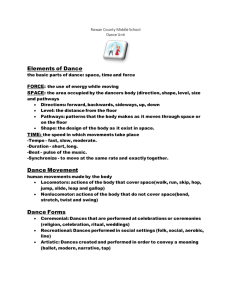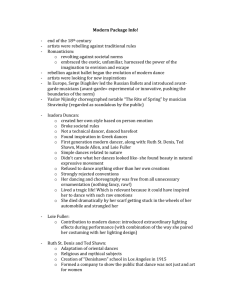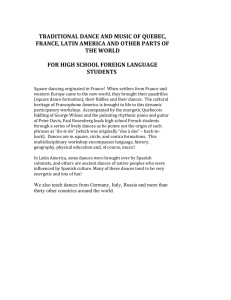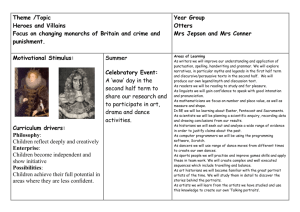From symbolic, ritualistic to folk and social dance, Part 1
advertisement
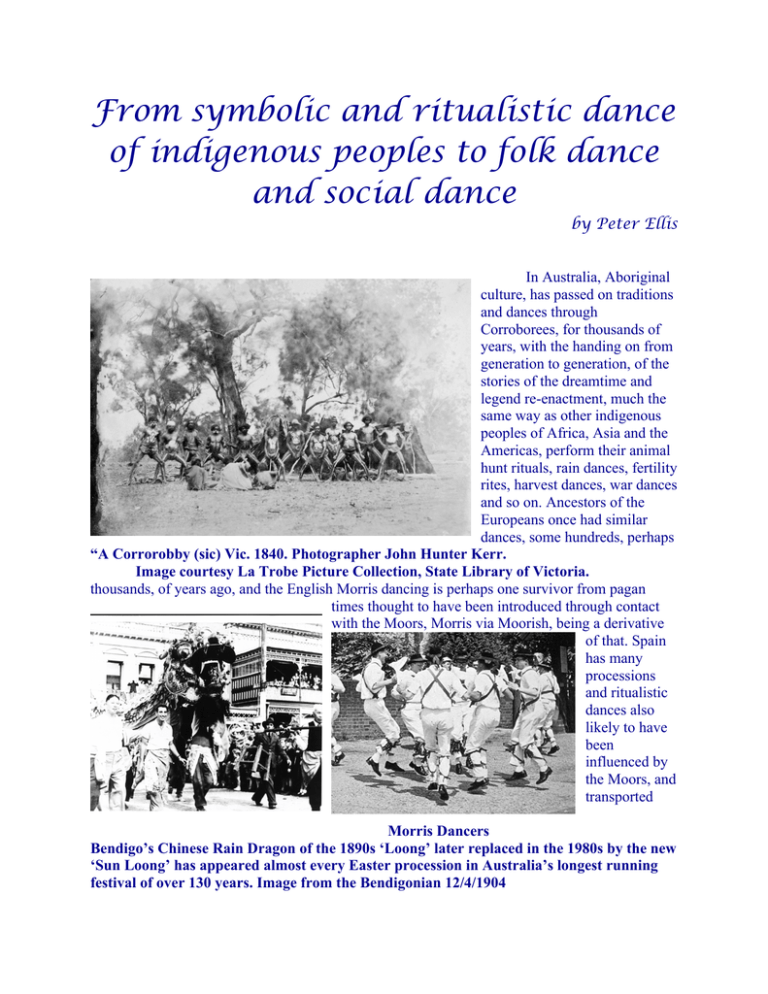
From symbolic and ritualistic dance of indigenous peoples to folk dance and social dance by Peter Ellis In Australia, Aboriginal culture, has passed on traditions and dances through Corroborees, for thousands of years, with the handing on from generation to generation, of the stories of the dreamtime and legend re-enactment, much the same way as other indigenous peoples of Africa, Asia and the Americas, perform their animal hunt rituals, rain dances, fertility rites, harvest dances, war dances and so on. Ancestors of the Europeans once had similar dances, some hundreds, perhaps “A Corrorobby (sic) Vic. 1840. Photographer John Hunter Kerr. Image courtesy La Trobe Picture Collection, State Library of Victoria. thousands, of years ago, and the English Morris dancing is perhaps one survivor from pagan times thought to have been introduced through contact with the Moors, Morris via Moorish, being a derivative of that. Spain has many processions and ritualistic dances also likely to have been influenced by the Moors, and transported Morris Dancers Bendigo’s Chinese Rain Dragon of the 1890s ‘Loong’ later replaced in the 1980s by the new ‘Sun Loong’ has appeared almost every Easter procession in Australia’s longest running festival of over 130 years. Image from the Bendigonian 12/4/1904 and mutated further, in the Latin countries of America. The ancient Britons and Celts through their druids likewise had there ritualistic dance and possibly even sacrifice. The Scottish ‘Auld Lang Syne’, probably derives from a much older superstitious or worship dance, perhaps around a totem such as the ancient tree, advancing and touching and retiring. The English Maypole dancing, usually in springtime, has a sexual connotation, believe it or not, the maypole itself a phallic symbol with the young lads or boys sitting at its base, and the girls (probably not knowing what they’re skipping around), holding the ribbons and dancing flirtatiously, to induce fertility. Tantawanglo School Picnic and Maypole Dance, NSW early 1900s. Image courtesy the Bicentennial Copying Project, State Library of New South Wales. All of this is lost in the antiquity of time, but the common thread of course, is that this type of dance is ritualistic and ceremonial. It is not social dance, and in fact it is probably only because of European development whilst at the same time breaking with traditional taboos, that social dance evolved at all, from early folk dance heritage. The cultures of the peoples of the other continents with their various strict customs, would never have allowed for innovation and the development of something as bold as a couple in the ‘bear hug’ hold of the waltz or quickstep. Needless to say, in Europe and prim and proper England, dances with such familiarity as the waltz, were banned for many years, even for as much as seventy years, in some parts, for example, Prague, the Czech capital. In Australia a variation of the Schottische with rocking or thrusting forward and back created a rather seedy version known as the Rocking Schottische which many MCs forbade from the dance arena. However social dances did evolve in the European countries and it is to the English, the Country Dance can be claimed, to the French, the Quadrille, and both examples generally at ‘arms' length’, as were their forerunners and counterparts of the renaissance. Then from the Germanic countries, the forbidden or demonic dances with the close hold, the Waltz, Galop , Polka (and Schottische), each in turn, became sensations pre-empting the later modern dances of the twentieth century, the One Step, Tango and Foxtrot. The Slavic countries also played a part with the development of the Mazurka, and Spain, through its music, influenced the English Country Dance with the emergence of ‘Spanish waltzes’. The English Country Dance gradually absorbed the German waltz via an established Allemande step and then took on Spanish music as the flavour of the period to perform these new set dances, around the turn of the 18th/19th century. Illustration: - The One Step (forerunner of the ballroom Quickstep) of the 1910s and 20s. The uninvited colonisation of the other continents by the various European nationalities, introduced social dance to the respective indigenous peoples. Sometimes as a result of hybridisation of cultures, new dances actually emerged from the New World to bounce back to Europe. The Tango, from Argentina, is one example, as well as the Latin American dances, Samba, Rumba and Cha Cha Cha, evolving from ethnic and indigenous population mixes in various South American countries. The ballroom examples of these dances are however, somewhat taken with license, compared to the original folk dances. In the United States of America, as a result of jazz and the improvisation of the African-American people, the free-lance modern ballroom dances evolved, firstly from the Left - the Tango demonstrated by Emily and Harry Leggett (1912) of Leggett’s famous ballroom Prahan Melbourne. Right - Phil and Beryl Leggett demonstrating the Carioca (Rumba) 1933 just after learning it from the latest film newsreel. ‘animal dances’ such as the Turkey Trot, Horse Trot, Fish Walk, Crab Crawl and Monkey to mention a few, and then as an offshoot, the One-Step and Foxtrot emerged, as well as other seasonal crazes such as the Charleston, Doing the Racoon, The Black Bottom and the Varsity Drag. Europe had earlier lost much of its pagan ritualistic traditions, partly because of the Church and then compounded as social dance instead emerged to challenge religious curfew, the same tended to happen in other countries as social dance spread. Although Aboriginal traditional legends and ritualistic dance have survived, at least to be recorded, the assimilation into modern lifestyle and as a result the reliance on convenience, has or will, undoubtedly result in a decline of continuing to act out the old customs, in much the same way as with other cultures on other continents. One can hope, a maintenance of interest by future generation custodians, much in the way the Scots and Irish, or the Germans have managed to collect, revive and maintain their folk dances, will be upheld by the Aboriginal peoples. What is generally not known by white Australians is that Aboriginal people, generally living on the fringes of towns, did take on the social dances and music of the fashion from Europe as it arrived. They held their own dances and had their own musicians on squeezeboxes and fiddles. Evelyn Crawford, an indigenous button accordion player of Brewarrina NSW 1994. Photograph by the late John Meredith from Pictures Catalogue, courtesy of the National Library of Australia. nla.pic-an 14320677-v. Collectors such as Chris Sullivan believe that in general the Aboriginal performers on these instruments actually had a finer feel to the music than their mainstream Anglo-Saxon counterparts. The Australian Institute for Aboriginal and Torres Strait Islander Studies (AIATSIS). Recordings by Chris Sullivan are lodged with the National Library of Australia and the skills in dancing were likewise of equal merit to the music. When at the Drover’s Camp at Camooweal in 2003 and 2004, I observed at the Old Time Dance I was asked to MC, and to play, several very good dancers of Aboriginal or part Aboriginal descent. One lady in particular was very graceful, and when I saw her again at the rodeo, I complimented her on her dancing. She thanked me graciously, and said, ‘we used to have dances on the clay pans, my dad taught me.’ Much in the way of social dance and music handed down from the nineteenth century has survived through the Tasmanian Aboriginal people of the Bass Straight Islands, in particular Cape Barren and Flinders, but at the same time, of shared performance, that has generally been lost by the British and European descended Tasmanians. Considerable interchange between collectors and the elders in assisting with the music and dance revival, is swelling at the time of writing, in encouraging recollections to be detailed of the old set dances, couple dances, step dances and the relevant music, known to those originally from those islands. It is also significant at the time of writing, that Cape Barren Island, where these traditions had been nurtured, has finally been handed back to the Aboriginal people after their ‘departure to the mainland’ i.e. Tasmania, in the 1950s. This in itself is a curious twist, because in the nineteenth century, the government of the day rounded up all the Aboriginal people from Tasmania and dumped them on the islands of Bass Straight, and declared them extinct following with the death of Truganini. Nevertheless, to the later generations that grew up on Cape Barren, with all their own old time music and dancing, just as our forebears used to do, very emotionally regard this as home. When the Brown brothers ‘were moved’ to Tassie in the 1950s, they played for dances in the halls and in the pubs and could step dance as well. This has been carried on by the younger generation, now becoming elderly, who can hand it on and who want to do it on Cape Barren Island and who are willing to share. Perhaps their tune ‘the black cat piddled in the white cat’s eyes’ captures some of the emotions of those times. Illustration: - Ronnie Summers (originally of Cape Barren Island) and niece Merinda Sainty (violinist) maintaining the tradition from the days of the Brown Brothers as well as more contemporary material. Photo courtesy Rob Willis. In terms of modern music the Aboriginal people are well holding their own. Again at Camooweal in 2003, I thought Gus Williams and his sons, grandson and nephew, all mainly from Hermannsburg, had the edge on the other Country and Western bands. Likewise, Yothu Yindi was an exceptional ‘Yolngu’ modern band. Kevin Bradley of the National Library of Australia at the time of writing points out that Aboriginal dance has adapted to contemporary times, there are many new dances and songs in Arnhem land, the tradition still flourishes and he was blown away by the lively culture in that part of the country. Also in the Centralian traditions, of which there are many, there are both traditional "dreamt" music, and recent compositions which reflect the present times.
